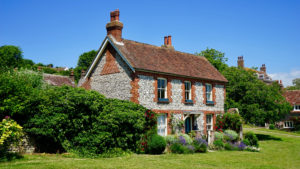
Thatched roofs, leaded windows, heavy oak front-doors and mellow brick or stone walls set in beautiful grounds; many people in England dream of owning such a property. However, when buying a historic building (either commercial or residential) it is extremely important to first find out whether or not it is “listed”.
This means that you have to consult the National Heritage List for England (‘NHLE’). This list details all nationally protected historic buildings. Historic England (the organisation that maintains the NHLE) sensibly says that “the older a building is, the more likely it is to be listed” and that “listing celebrates a building’s special architectural and historic interest”.
 Should an owner of a “listed” building want to carry out any alterations or extensions to it, then it is always a very good idea to check firstly with the local planning officer (or via the local planning authority’s website) if the building in question is, in fact, “listed” and if so, whether the proposals for the building will be acceptable. A listed building consent is an additional requirement to the need for “standard” planning consent. It is a criminal offence to carry out work to a listed building without first obtaining the necessary listed building consent, and it is not an acceptable defence to say that the owner did not know that the building is “listed”.
Should an owner of a “listed” building want to carry out any alterations or extensions to it, then it is always a very good idea to check firstly with the local planning officer (or via the local planning authority’s website) if the building in question is, in fact, “listed” and if so, whether the proposals for the building will be acceptable. A listed building consent is an additional requirement to the need for “standard” planning consent. It is a criminal offence to carry out work to a listed building without first obtaining the necessary listed building consent, and it is not an acceptable defence to say that the owner did not know that the building is “listed”.
The maximum penalty for carrying out unauthorised works to a “listed” building is two years’ in prison or an unlimited fine. As well as facing these penalties, the owner may also be required to reinstate the changes that have been made to the building. This could prove to be a very expensive task, as equivalent building materials and traditional methods of construction may also be required to be used.
As well as the main structure or building, it is also quite possible that adjoining or adjacent walls or even such things as elaborate garden ornaments (like urns or pillars either side of a driveway) can be listed. If so, they would also be subject to the same strict rules relating to any alterations. This must also be taken into account when considering any redevelopment or renovation proposals.
In light of all the above, we would strongly advise that you check NHLE on Historical England’s website, prior to purchasing a property, if you have any suspicion that it may be listed.
We are always happy to provide any further in-depth advice to anyone concerned about the “listed” status of their property or any steps that need to be taken in light of any proposed works to a “listed” property.
For further information regarding the topics discussed in this post, please contact BHW’s Commercial Property team on 0116 289 7000 or email info@bhwsolicitors.com.
Categorised in: Commercial Property, News, Residential Property
Tags: Commercial Property, Listed Building, Residential Property